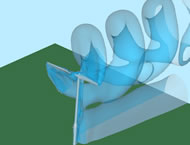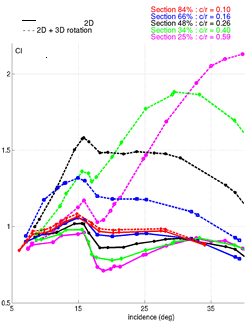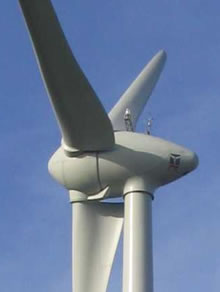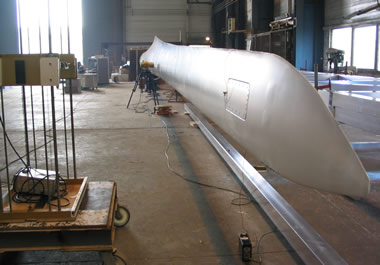Wind Turbines, Computers in the Fields
Onera researchers are working on the behaviour of wind turbines. Objective: to improve their performances in all wind speeds and also to build even more powerful wind turbines. The solution may lie in more flexible blades.
Number 38
 Visualization of the wake of a wind turbine by numerical simulation |
Taller, heavier, more powerful: just like athletes, wind turbines break records year after year. Objective: to produce large quantities of electricity at moderate cost. A wind turbine is made up of three parts: the tower, which supports the whole assembly, the nacelle, which contains the electricity generator along with the accessory equipment (brake, electronic controller, etc.) and finally the rotor, which is itself made up of the blades and the main shaft. Onera is mainly interested in the rotor, but also in questions related to wind turbines, such as the measurement of winds and the radar interference caused by wind turbines. |
| The blades are generally made of glass fiber impregnated with polyester or epoxy resins. But these composite materials are very difficult to model. "We are trying to understand the aerodynamics of the blades (air flows around airfoil) and their aeroelasticity (the way in which the structure is deformed by the combined action of the wind and the rotation of the blades), says Marc Rapin, research engineer at Onera. Because this deformation modifies also their aerodynamics." Onera is already interested in this subject, from its work on helicopters. However, the aerodynamics of wind turbines are very different from those of helicopters: wind turbines rotate at low speed, which means that they are more sensible to atmospheric turbulence. "Variable winds create many different variations at different scales, which modify the local aerodynamics, the researcher explains. All of which increase fatigue of the blades." |
|
 Large modifications of the lift coefficient Cl depending on the span with the three dimensional effects of rotation taken into account (dotted lines) or without those 3D effects (solid lines). |
To get a better understanding of these phenomena, researchers divided the blades numerically into small sections and then calculated their mechanical characteristics using programs adapted to these types of composites. They then performed aeroelasticity calculations (using the Rotor code) and aerodynamic calculations using the elsA simulation software. "This program was created for blades working at high speed. We adapted it to the low speeds of wind turbine blades". It is used to model the wake behind the wind turbine. The main difficulty lay in modeling the separation of the "boundary layer", a very thin layer of air in contact with the blade that can "separate" and lead to a reduction of performances. "In fact, separations of this boundary layer occur constantly in wind turbines. When the blades start, it's due to the parts close to the shaft. Then, when the wind gets stronger, these sections no longer work, because the air is separated there, and the outboard parts of the blade take over." Therefore, only 30 to 40 % of a wind turbine blade operates at nominal power. |
| To improve these performances, "pitch" regulated wind turbines have been designed and are increasingly replacing "stall" regulated wind turbines. The latter have fixed blades with a twisted shape (about 20 degrees between the root and the end of the blade) so that it works progressively for winds between 4 and 25 meters per second. When the wind speed is low, the blade root, whose angle is large compared to the plane formed by the three blades, starts the rotation of the blades. At high speed, on the contrary, this is the blade tip which is working. For pitch regulated turbine, motors rotate the blade according to the wind speed. Therefore, the blade twist is lower because the whole blade adapts to the wind. "These pitch wind turbines are more complicated due to the control system, but have better performances than the stall wind turbines, says Marc Rapin. Today, they represent almost all of the average and high power machines, that is about 95% of the current world market." |
 Pitch type wind turbines have blades that change direction according to the force of the wind, for winds between 4 and 25 meters per secon |
|
The aim of the Onera work is to optimize the twist angles of the blades according to the local wind conditions. Apart from improving performances, this will also reduce the stresses on the rotor and therefore the fatigue of the materials. "Wind turbine blades are very rigid. Therefore, all aerodynamic moments are concentrated on the roots of the blades, where they are fitted to the hub. This means that they have to be very strong to avoid breakage problems". Hence the weight problem in the rush towards giant wind turbines: for 5 megawatt prototypes, each 61.5 meter long blade weighs around 20 tons, which must in turn be supported by a colossal nacelle and tower. So the wind turbine weighs between 400 and 500 tons! "That's the limit of what we can manufacture, transport and predict" he emphasizes. Maybe progress will take the form of more flexible blades, in which the deformations absorb some of the aeroelastic forces. The blade root could then be lighter. The downside is that torsion increases the problems of stall of the boundary layer. The optimum is yet to be found.
Cécile Michaut, scientific reporter. |
|
